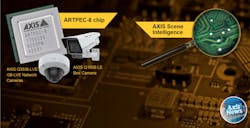This year marks the 25th anniversary of the invention of the IP camera by Axis Communications founder Martin Gren and while the camera itself, the NetEye 200, was fairly basic by today’s standards – capable of transmitting a single frame every 17 seconds – it was a device that would fundamentally change the video surveillance landscape forever. The companies that once dominated the analog camera market are largely just shells of their former selves or defunct entirely, while companies like Axis and others on the leading edge of network connectivity now dominate the industry.
More than two decades later, the market stands on the precipice of yet another watershed technology moment as Artificial Intelligence and Deep Learning-powered solutions continue to gain wider acceptance by integrators and end-users alike. In recognition of this, Axis on Monday officially unveiled its ARTPEC-8 system-on-chip (SoC), which will bring these next generation analytic capabilities to its product lineup on the edge.
During a virtual press summit held in conjunction with the opening of GSX, Johan Paulsson, Chief Technology Officer at Axis Communications, said that ARTPEC-8 will, as usual, provide enhanced capabilities when it come to things like image quality, low-light imaging, and video compression; however, one of the most important functionalities provided by the SoC is that it will enable the company to support analytics applications on the edge, beginning with the AXIS Q3536-LVE/38-LVE dome cameras and AXIS Q1656 box cameras that were also launched during the show.
“It’s a big step forward,” Paulsson said. “ARTPEC-8 includes a built-in, Deep Learning processor, creating new opportunities for impressive analytic applications based on Deep Learning at the edge.”
One of the things that differentiates ARTPEC from other SoCs, according to Paulsson, is that is most other chipsets are designed for the consumer market while Axis has designed ARTPEC specifically for the commercial video surveillance space.
“Even if we used some of the base technology like H.264, H.265 and other things – coming really from a consumer’s market – we actually tweak it so that it really performs better in our use cases,” he explained. “Zipstream is a perfect example. You can use Zipstream with H.264 and H.265 decoding, so we use the technology in an optimized way. I think we have a big advantage developing our own chip and, as I said, in using our knowledge of the market.”
Moving forward into next year, Paulsson said ARTPEC-8 will enable the company to make Deep Learning capabilities available more broadly in its product portfolio.
“It is really making high-end and accurate analytics available in every product. That is quite unique,” he added. “We think this technology is so interesting that it should be a part of every, single camera.”
On the software side, Paulsson said the company has developed what it calls “Axis Scene Intelligence” technology to help users derive even more intelligence out of their camera deployments by taking advanced image processing and analytics at the edge and enhancing it on the backend.
“Technologies like Deep Learning make it possible to extract more and more relevant information from a scene. This technology will also make it possible to optimize the video image itself based on what is most relevant in the scene for a specific use case. It is also basically improving scene understanding to help operators look at live video creating what I call ‘assisted surveillance,’ and this is something we will hear much more about in the future,” explained Paulsson. “To put it into perspective, Scene Intelligence is a new technology that will give us a lot of new things, including analytics and metadata, but much more.”
To learn more about ARTPEC-8, Axis Scene Intelligence or any of the other products the company is showcasing this week at GSX, drop by booth #1341.
Joel Griffin is the Editor of SecurityInfoWatch.com and a veteran security journalist. You can reach him at [email protected].




